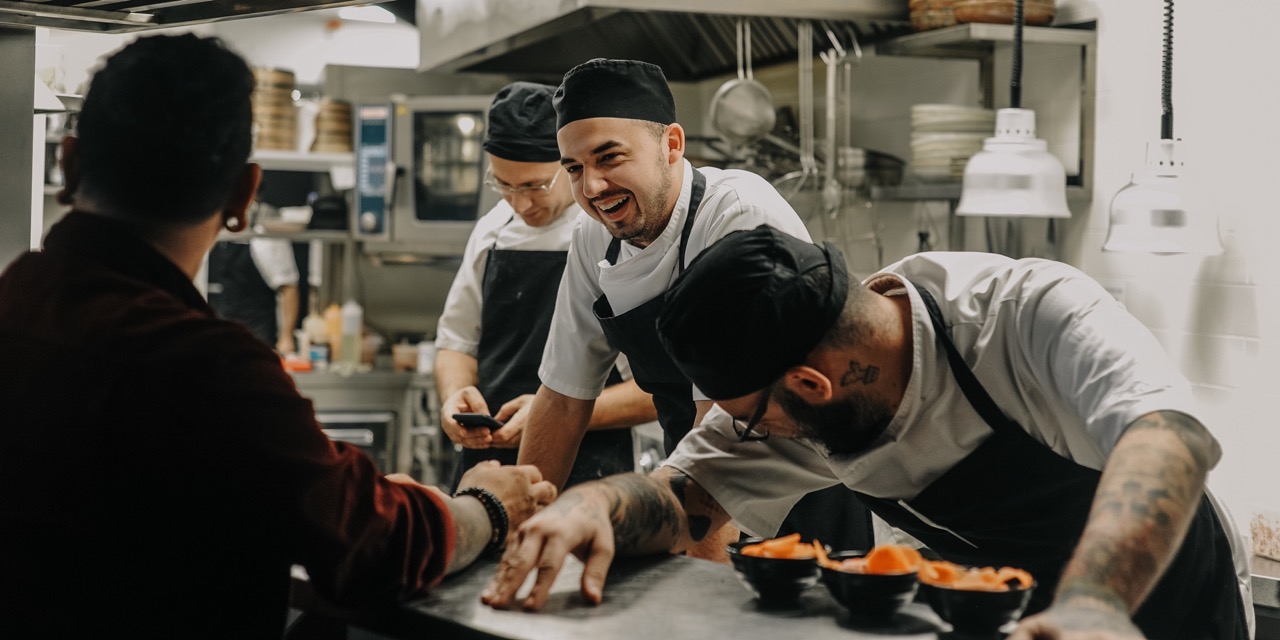Restaurant Hiring/Staff 101: Comprehensive Guide
Table of Contents

Restaurant hiring/staff 101: comprehensive guide
You’ve refined your restaurant idea, rented space, purchased equipment, and perfected your menu, but there’s one more crucial piece to fit into place before your joint’s grand opening: the staff.
The staff is the heart of any beloved restaurant, and your employees will shape every part of the customer experience—from meeting the friendly host’s eyes at the entrance to devouring every colorful morsel on their plate.
If you’re stumped on how to hire restaurant staff, look no further. This guide outlines the process of assembling your team, from crafting detailed job descriptions to interviewing candidates to training and retaining staff.
Read on to learn how to staff your restaurant, from start to finish (and how CloudKitchens can help).
Building a dream team
It’s no secret that the staff can make or break a restaurant. Choosing both front-of-house and back-of-house staff who are reliable, enthusiastic, and committed to serving will help make your restaurant experience outstanding for customers.
But restaurant teams tend to be small, turnover is quick, and the majority of Americans will work in a restaurant at some point—so it’s important to find employees who are there for the right reasons, passionate about the restaurant industry, and eager to get the job done.
As 90% of restaurant leaders start in entry-level positions, you’ve likely been in your employees’ shoes. So consider what you’d look for in a supervisor and do your best to implement those practices as you build a healthy work environment. Do your best to find employees who complement each other’s strengths and value teamwork.
Be sure to hire adequate staff, too, as research shows that a heavy workload leads to not only employee burnout, but also a decline in guest satisfaction and an increase in operational costs.
Your staff is the face of your restaurant and directly shapes your customers’ experience, so find team members committed to keeping customers happy, and do your part to keep them happy in return.
Developing job descriptions
Set yourself up for hiring success at the source. Provide as much detail as possible in your job descriptions, including information about scheduling, wages, benefits, and specific job duties, as well as your restaurant’s concept and your management style. Setting expectations upfront will attract more candidates who are a good fit for your restaurant.
You’ll need to create job postings for the following positions:
- Manager(s)
- Head chef
- Line cooks
- Bussers/dishwashers
- Servers
- Bartenders
- Hosts
- Food runners or expos to help with plating and running orders to tables, depending on your restaurant’s needs
- Maintenance/custodial employees

Conducting interviews
You’ll need to interview candidates for a variety of positions, from managers to servers to bussers to chefs and line cooks. Be sure to schedule interviews during off-hours or at least during slow times at the restaurant so that you can give each candidate your undivided attention.
Print a copy of each candidate’s resume beforehand and familiarize yourself with their past experience to inform the questions you’ll ask. Conducting the interview in the dining room or at the bar of your restaurant can feel less intimidating for the candidate than being interviewed in an office, but be sure to choose a table with some level of privacy (like a high-top or booth in the back).
Try to get a sense of your candidate’s personality, background, and personal and professional goals. Ask how they got into the restaurant industry and why they feel they’re a good fit for the position. You might also choose to ask standard interview questions, such as why the candidate left their former job, what they see as their professional strengths and weaknesses, and how they work on a team.
Some restaurants offer “working interviews” or “staging,” where candidates actually work a shift in their desired position. It’s up to you whether you’d like to offer “staging” to see how candidates work in practice, and whether you’d like to offer a traditional “non-working” interview in addition.
Evaluating candidates
Once you’ve interviewed all qualified candidates, you can start building your team. Choose candidates who complement each other’s strengths (i.e. a strong leader, someone with sharp attention to detail, someone skilled at interacting with customers).
Asking for professional references in the evaluation process is also a good idea, and can give you a sense of a candidate’s previous experience in the restaurant space. Asking for references also requires more effort from each applicant, ensuring you’ll receive candidates who are serious about the job.
Fill each team (front-of-house, back-of-house, managers and head chef) with experienced professionals, but don’t be afraid to give one or two dedicated newbies a chance as well.
Training & retaining
It’s crucial to develop a training program that encompasses everything your employees might need to know or encounter on the job. Start by simply asking your employees what they want to learn or how they wish to improve.
Take the time to become an expert on what you’re teaching, and stay up to date on the latest methods (i.e. keeping track of hours online, keeping track of orders sent via tablet, QR code menus, etc.). Be sure to express that you’re always here should your employees have questions.
Once you’ve built and trained your team, your job as a leader is to support them. Do your best to promote a positive work culture. Develop systems for accommodating employees’ needs (i.e. an open-door policy, the ability to call out of or swap shifts with notice as needed) and adopt a zero-tolerance policy for disrespect amongst team members.
Keeping your team supported and satisfied in the job also means mitigating burnout and other stresses. Be sure to be mindful of over-scheduling employees and field conflicts with customers as necessary. Consider setting up periodic check-ins with each employee or offering an anonymous box for questions, complaints, and concerns.
Finally, be sure your restaurant is compliant with employment laws. Pay your workers fairly in accordance with state minimums, and do not discriminate based on factors like race, age, or gender identity when hiring. If you need to schedule employees for extra shifts, be mindful of compensating them appropriately for overtime.
Simplify and reduce staff management with CloudKitchens
If you’re overwhelmed in the process of staffing a full restaurant, CloudKitchens might be the right option for you. When you rent a CloudKitchen ghost kitchen, you’ll already have the tools in place to fulfill delivery orders, from basic cooking equipment to a tablet with a streamlined platform for orders from various delivery services. We have locations all over the US, so if you need a commercial kitchen in Austin or a commercial kitchen in Miami, we are ready to improve your efficiency to empower your food business journey.
Explore ghost kitchen locations across the US:
- Ghost kitchens in Seattle
- Ghost kitchens in San Francisco
- Ghost kitchens in LA
- Ghost kitchens in NYC
- Ghost Kitchens in Toronto
- Ghost Kitchens in Atlanta
- Ghost Kitchens in Dallas
- Ghost Kitchens in Chicago
- Ghost Kitchens in Denver
- Ghost Kitchens in Miami
| DISCLAIMER: This information is provided for general informational purposes only and the content does not constitute an endorsement. CloudKitchens does not warrant the accuracy or completeness of any information, text, images/graphics, links, or other content contained within the blog content. We recommend that you consult with financial, legal, and business professionals for advice specific to your situation. |
Sources:
National Restaurant Association. National Statistics. https://restaurant.org/research-and-media/research/industry-statistics/national-statistics/
LinkedIn. How employee workload affects the restaurant business model → And how to manage it in order to lower turnover. https://www.linkedin.com/pulse/how-employee-workload-affects-restaurant-business-model-jim-taylor/
Indeed. How to conduct restaurant staff interviews. https://www.indeed.com/hire/c/info/how-to-conduct-restaurant-staff-interviews?gclid=Cj0KCQiA5rGuBhCnARIsAN11vgTYkd23gbUVfndRmBno3vnRgbJbz-Hnt7athNVq7XL8kuLgGYy-aboaAklFEALw_wcB&gbraid=0AAAAADfh6_swetl8SPvGwlA3hn8h7DJQr&aceid=&co=US&gclsrc=aw.ds
LinkedIn. What are some of the skills or competencies that you need to be an effective employee trainer? https://www.linkedin.com/advice/0/what-some-skills-competencies-you-need-effective-1c?src=go-pa&trk=sem-ga_campid.20321745998_asid.149140187205_crid.664020243553_kw._d.t_tid.dsa-2085021239220_n.g_mt._geo.9003733&mcid=7080236969011671040&cid=&gbraid=0AAAAADpfA-1nMMXXcwEQfA0-o5FBd7B5i&gclid=Cj0KCQiA5rGuBhCnARIsAN11vgRyyQYEZwoxE2C3mHgAymhk1ocnxBc0bMpXFsBHa6fDsK0h4-IChNUaAiENEALw_wcB&gclsrc=aw.ds
More insights & stories

